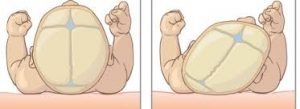Flat head syndrome or positional plagiocephaly in most cases, is a completely reversible ailment which occurs in young babies.
A way to alleviate flat head syndrome is by ensuring rotation of the head. This ensures that the force applied around the soft, delicate skull is even. If the pressure is applied in the same spot, it may actually cause an indentation in the pliable skull inadvertently causing flat head syndrome.
Imagine you are baking a cake and you need to make a fondant hulk hand to protrude out of the sponge. Before you can mold the fondant, you need to warm it up by rubbing it evenly and working the icing in all directions.
The softer it becomes, the more pliable it is to work with.
Think of your newborn baby’s skull as a tiny little hulk hand just waiting to be molded. Babies heads are soft, and the bones are joined by equally soft cartilage. Due to this soft cartilage,we are told from birth how delicate the opening at the top of babies heads are. Early intervention is key, as when baby gets older, his bones harden making it all the more difficult to mold back into shape.
Four ways to prevent flat head syndrome at home:
There are certain ways you are able to ensure that baby’s head doesn’t fixate in one spot. These four small practices can all be done in the comfort of your own home.
Tummy Time:
Tummy time. This is where you place baby on their belly. This will help baby develop control of their heads and bodies. Tummy time gives your baby the opportunity to strengthen the muscles he needs to prepare him for rolling, crawling, and pulling himself up. Some baby’s are big fans, although some babies, especially mine, used it to strengthen their vocal cords instead. Fans, not so much. If you find that your baby doesn’t like being placed on their tummies for long periods of time, reduce the amount of time spent on the ground, but increase the frequency.
Play time matters:
In addition to tummy time, in order to apply equal pressure around baby’s head get him rotating his head left to right. You can do this by playing games with your bub. Shake their favourite toy on either side to encourage head movement. Or give your other children an extra special job by allowing them to take turns at calling their sibling from either side.
Change positions:
Change the way you position the baby. This is especially important when feeding or relaxing on the couch with bub. If you are constantly placing baby on the same side, you are creating a memory foam like position in your baby’s skull. Try to be mindful of this by changing feeding positions or even laying baby across your knees on their tummy to relieve any pressure on their heads.
Rotate baby’s head:
Gently rotate the baby’s head if you find that he is constantly sleeping in the same position. Nothing major, just turn your baby’s head gently to the opposite side. This is especially relevant during their day sleeps, when you are awake and able to monitor their sleeping patterns.
If you are particularly worried about your baby, and would like to get an assessment done, there are many types of practitioners qualified to assess and diagnose these conditions. These include Pediatricians, Mothercraft nurses, Osteopaths and Physiotherapists.
Your general practitioner should be able to help and refer you to the appropriate specialist.
Did your baby suffer from flat head syndrome? What methods did you use to rotate your babies head?












It is important to note that sometimes this happens due to position of bub in utero, complicated delivery or fast delivery. My daughter had this haooen as a result of haematomas on her head due to vacuum extraction. My son had this problem due to stiff joints in his neck and spine either due to position in utero or his rapid birth. He actually wasn’t able to turn his head one way. Its very important to seek professional help if you think you baby is getting a flat spot. We saw an osteopath at 6weeks and even with 1 treatment the difference in my son was dramatic.